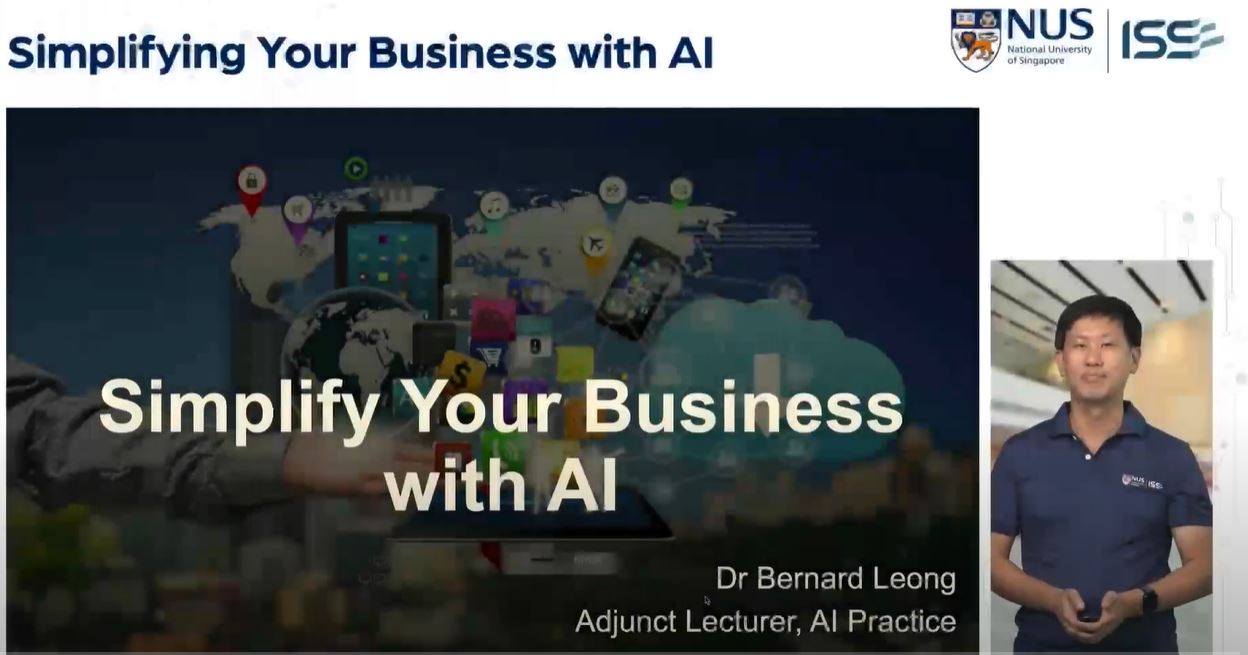Businesses today recognise the immense potential that artificial intelligence (AI) holds for transforming their productivity and driving growth. But to truly harness its power, companies will need to implement a clear, structured framework.

Dr Bernard Leong, Adjunct Lecturer, Artificial Intelligence Practice, NUS-ISS; speaking on the topic 'Simplifying Your Business with AI'.
“Attempting to inject AI haphazardly into your workflow can create bottlenecks and disrupt other processes,” says Dr Bernard Leong, Adjunct Lecturer, Artificial Intelligence Practice, NUS-ISS.
He recommends businesses to adopt a subtractive process, called the ESSA method: Eliminate, Simplify, Standardise and Automate.
First, Bernard says, analyse your workflow to identify areas where AI can eliminate unnecessary steps, redundancies, and bottlenecks. The next step is to focus on simplification by reducing information overload and unnecessary reporting steps. “Then, standardise by creating consistent and uniform processes. With the first three steps accomplished, you can then confidently automate your workflow, allowing AI to enhance productivity seamlessly,” he explains.
Streamline to reduce errors
What would that look like in a real-world setting? Bernard gives an example of an actual implementation he spearheaded as the former CIO of a Singapore construction conglomerate.
In the original workflow, a procurement person on site receives an invoice from a supplier or subcontractor. This invoice is uploaded into Microsoft SharePoint, where it is reviewed by the procurement department at the headquarter.
Once reviewed, the invoice is converted into a payment certificate, which is sent to the supplier for goods delivery and payment processing. This process involves multiple internal emails for approval from various stakeholders.
Finally, the payment certificate and invoice need to be uploaded into another SharePoint for the finance team to input into their enterprise resource planning (ERP) system. This means three different people – the procurement person on site, the procurement manager at HQ, and the finance director – all need to re-enter the invoice details.
“This redundancy is inefficient and prone to errors,” Bernard says. “The simplest way to streamline this workflow is to ensure that data is input only once, providing a single source of truth digitally.”
To achieve this, the digital team started from the source. When the first invoice arrives at the construction site, the procurement person uploads a digital copy into the system. This copy is then scanned by an AI Optical Character Recognition system, such as Amazon Textract or Azure Form Recognizer. The information is verified by someone at the headquarter, and a payment certificate is generated. This certificate goes through a digital approval process, which can be tracked electronically. “Once verified, the same data is pushed into the financial ERP system. This approach simplifies the entire process,” Bernard explains.
AI enters the mainstream
We are only at the beginning of the AI revolution. On 30 November 2022, US-based research organisation OpenAI released ChatGPT – and the rest is history.
Since its launch, ChatGPT has found diverse applications, ranging from generating recipe ideas and developing travel plans to extracting and summarising content from news sites. It has also proven valuable in data analysis of small data sets and even in generating code.
So what exactly is ChatGPT? “The innovation was based on a famous paper published by Google researchers called ‘Attention is All You Need’, which outlined the transformer architecture that led to the creation of GPTs, or Generative Pre-trained Transformers,” Bernard explains. GPT models are neural network-based language prediction models that can analyse natural language queries, known as prompts, and predict the best possible response based on their understanding of language.
Another useful concept to know is LLMs, or Large Language Models. “They are the bedrock to generative AI,” Bernard shares. “LLMs are pre-trained using a vast amount of data at scale, and can be adapted by fine tuning, using reinforcement learning with human feedback or in context learning.” Features of LLMs include writing essays, creating charts and websites, or generating computer codes.
The road ahead
With the rapid innovations emerging from generative AI, how can NUS-ISS support you and your business on this journey? “We offer a variety of graduate programmes and Executive Education Programmes tailored to your needs in AI and machine learning,” says Bernard. “They are designed to jumpstart your AI journey and help you effectively integrate AI into business operations."
Two recently launched courses and one upcoming new course were designed to cater to the needs of businesses and government institutions:
-
The two-day (Generative) AI for Business Leaders (or Government Leaders) course aims at helping senior executives think strategically and comprises hands-on workshops on how they can use generative AI to improve team productivity.
-
The (Generative) AI to Supercharge Products & Workflows course, held over two days, uses real-world case studies to teach businesses how to integrate AI into their processes and manage exceptions.
-
The upcoming Enterprise Large Language Models (LLMs) course, designed for companies that want to create their own language models, guides participants through fine-tuning large language foundation models with reinforcement learning.
“Through these tailored programmes, NUS-ISS can help you navigate the complexities of AI implementation, ensuring that your business not only adapts to but thrives in the AI-driven future,” Bernard says.
Watch the recorded webinar on NUS-ISS' YouTube Channel
here.
For more information on NUS-ISS Executive Education Programmes in Artificial Intelligence, visit
here.